- Clone
- 7H22-E16 (See other available formats)
- Regulatory Status
- RUO
- Other Names
- BR3, BAFFR, BAFF receptor, TNFRSF13C, B cell-activating factor receptor, BLys receptor 3
- Isotype
- Rat IgG1, κ
- Ave. Rating
- Submit a Review
- Product Citations
- publications
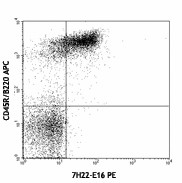
-

C57BL/6 mouse splenocytes stained with purified 7H22-E16 conjugated to PE (upper) or rat IgG1 PE isotype control (lower panel) and CD45R/B220 APC. -

-

Recombinant mouse BAFFR (Black Circles, Cat. No. 756506) binds to immobilized recombinant mouse BAFF (Cat. No. 591202). Anti-mouse BAFFR antibody (Purple Squares, Clone 7H22-E16) inhibits the binding in a dose-dependent manner. This antibody blocks the binding of 0.2 µg/mL recombinant mouse BAFF protein to 1 µg/mL of immobilized recombinant mouse BAFFR with an ND50 = 0.15-1.5 µg/mL.
| Cat # | Size | Price | Quantity Check Availability | Save | ||
|---|---|---|---|---|---|---|
| 134107 | 100 µg | 216€ | ||||
| 134108 | 1 mg | 572€ | ||||
BAFF (B cell-activating factor belonging to the TNF family) receptor (BAFF-R) is one of the three receptors that bind to BAFF. It is a type III transmembrane TNF receptor family member. BAFF-R is expressed at high levels in resting B cells and at lower levels in activated B cells, a small subset of activated/memory CD4+ T cells. It is a major mediator of BAFF dependent co-stimulatory response in peripheral B and T cells. It was reported that the mice expressing defective BAFF-R have disrupted B cell maturation. BAFF receptor appears to be particularly important for the regulation of normal B cell survival and maturation, as well as in the pathophysiology of aggressive B-cell malignancies and autoimmune diseases.
Product DetailsProduct Details
- Verified Reactivity
- Mouse
- Antibody Type
- Monoclonal
- Host Species
- Rat
- Immunogen
- Mouse BAFF receptor transfected rat RBL cells
- Formulation
- 0.2 µm filtered in phosphate-buffered solution, pH 7.2, containing no preservative.
- Endotoxin Level
- Less than 0.01 EU/µg of the protein (< 0.001 ng/µg of the protein) as determined by the LAL test.
- Preparation
- The Ultra-LEAF™ (Low Endotoxin, Azide-Free) antibody was purified by affinity chromatography.
- Concentration
- The antibody is bottled at the concentration indicated on the vial, typically between 2 mg/mL and 3 mg/mL. Older lots may have also been bottled at 1 mg/mL. To obtain lot-specific concentration and expiration, please enter the lot number in our Certificate of Analysis online tool.
- Storage & Handling
- The antibody solution should be stored undiluted between 2°C and 8°C. This Ultra-LEAF™ solution contains no preservative; handle under aseptic conditions.
- Application
-
FC - Quality tested
Block - Verified - Recommended Usage
-
Each lot of this antibody is quality control tested by immunofluorescent staining with flow cytometric analysis. For flow cytometric staining, the suggested use of this reagent is ≤ 0.25 µg per million cells in 100 µl volume. The antibody blocks the binding between recombinant mouse BAFF (Cat. No. 591202) and recombinant mouse BAFFR (Cat. No. 756506). The ND50 range is 0.15 - 1.5 μg/mL. It is recommended that the reagent be titrated for optimal performance for each application.
- Application References
-
- Ng LG, et al. 2006. Eur. J. Immunol. 36:1837.
- Ng LG, et al. 2004. J Immunol. 173:807.
- Batten M, et al. 2000. J. Exp. Med. 192:1453.
- Fu L, et al. 2009. Blood 113:4627.
- RRID
-
AB_2814029 (BioLegend Cat. No. 134107)
AB_2814029 (BioLegend Cat. No. 134108)
Antigen Details
- Structure
- A type III transmembrane TNF receptor family member
- Distribution
-
Expressed on most B cells, a small subset of CD4+ T cells.
- Function
- Play an importance role in B cell development, maturation, and survival.
- Ligand/Receptor
- BAFF (BLyS)
- Cell Type
- B cells, T cells
- Biology Area
- Immunology
- Molecular Family
- CD Molecules, Cytokine/Chemokine Receptors
- Antigen References
-
1. Thompson JS, et al. 2001. Science 293:2108.
2. Schiemann B, et al. 2001. Science 293:2111.
3. Batten M, et al. 2000. J. Exp. Med. 192:1453.
4. Fu L, et al. 2009. Blood 113:4627. - Gene ID
- 72049 View all products for this Gene ID
- UniProt
- View information about CD268 on UniProt.org
Related FAQs
- Do you guarantee that your antibodies are totally pathogen free?
-
BioLegend does not test for pathogens in-house aside from the GoInVivo™ product line. However, upon request, this can be tested on a custom basis with an outside, independent laboratory.
- Does BioLegend test each Ultra-LEAF™ antibody by functional assay?
-
No, BioLegend does not test Ultra-LEAF™ antibodies by functional assays unless otherwise indicated. Due to the possible complexities and variations of uses of biofunctional antibodies in different assays and because of the large product portfolio, BioLegend does not currently perform functional assays as a routine QC for the antibodies. However, we do provide references in which the antibodies were used for functional assays and we do perform QC to verify the specificity and quality of the antibody based on our strict specification criteria.
- Does BioLegend test each Ultra-LEAF™ antibody for potential pathogens?
-
No, BioLegend does not test for pathogens in-house unless otherwise indicated. However, we can recommend an outside vendor to perform this testing as needed.
- Have you tested this Ultra-LEAF™ antibody for in vivo or in vitro applications?
-
We don't test our antibodies for in vivo or in vitro applications unless otherwise indicated. Depending on the product, the TDS may describe literature supporting usage of a particular product for bioassay. It may be best to further consult the literature to find clone specific information.
Other Formats
View All CD268 Reagents Request Custom Conjugation| Description | Clone | Applications |
|---|---|---|
| Purified anti-mouse CD268 (BAFF-R) | 7H22-E16 | FC |
| PE anti-mouse CD268 (BAFF-R) | 7H22-E16 | FC |
| Alexa Fluor® 647 anti-mouse CD268 (BAFF-R) | 7H22-E16 | FC |
| Ultra-LEAF™ Purified anti-mouse CD268 (BAFF-R) | 7H22-E16 | FC,Block |
Compare Data Across All Formats
This data display is provided for general comparisons between formats.
Your actual data may vary due to variations in samples, target cells, instruments and their settings, staining conditions, and other factors.
If you need assistance with selecting the best format contact our expert technical support team.
-
Purified anti-mouse CD268 (BAFF-R)
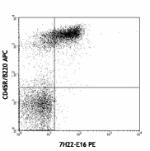
C57BL/6 mouse splenocytes stained with purified 7H22-E16 con... 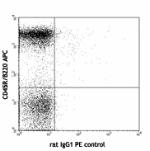
-
PE anti-mouse CD268 (BAFF-R)

C57BL/6 mouse splenocytes stained with 7H22-E16 PE (upper) o... 
-
Alexa Fluor® 647 anti-mouse CD268 (BAFF-R)
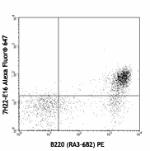
C57BL/6 splenocytes double stained with 7H22-E16 Alexa Fluor... 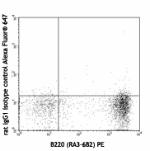
-
Ultra-LEAF™ Purified anti-mouse CD268 (BAFF-R)

C57BL/6 mouse splenocytes stained with purified 7H22-E16 con... 

Recombinant mouse BAFFR (Black Circles, Cat. No. 756506) bin...

 Login / Register
Login / Register 









Follow Us